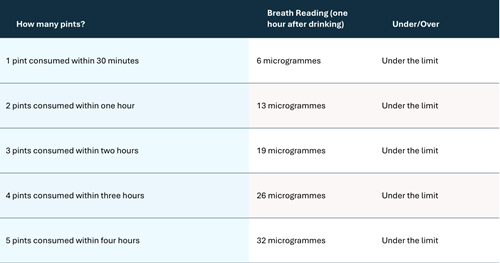.
If you are reading this article, you have probably been pulled over and breathalysed by the police, and you're probably wondering what happens next! Well it all depends on a variety of things :
-
Did the police follow the correct procedure?
-
Did you only have a roadside test? Or were you taken to the police station for the evidential breath test?
-
What was your breath reading?
.
Firstly, we have to determine whether the roadside breath test was taken in lawful circumstances. For the police to have reason to believe you are driving under the influence of drink or drugs, and therefore giving them the authority to require you to do a breath test, you would need to have committed one of the following things:
-
Committed a moving traffic offence (speeding, running a red light etc)
-
Driving in a reckless or careless manner (or sometimes driving TOO cautiously can raise suspicions!)
-
Involved in a road traffic accident
-
Fault with the vehicle (i.e break/headlight out)
.
Any of the above can raise suspicions to the police that you are not in full control of the vehicle and could suggest you are impaired or intoxicated. A fault with the vehicle does not immediately suggest that you are under the influence, the police could just pull you over and give you a warning, however if when you speak to them you are showing signs of impairment (i.e glazed eyes, smell of alcohol) they could then proceed to ask you to do a breath test based on the physical signs you are showing.
.
Refusing to provide a breath test when requested, without a reasonable excuse (i.e medical condition) is an offence and can leave you liable for prosecution. The penalty for failing to provide a sample is actually much harsher than the penalty for drink driving alone and can even result in prison (unless your breath reading was over 120mcg which is where prison sentences for drink driving begin).
.
What is the legal drink driving limit in the UK?
.
The legal alcohol limit in the United Kingdom for driving is 80 milligrams of alcohol per 100 millilitres of blood, 35 micrograms of alcohol per 100ml of breath, or 107 milligrammes per 100 millilitres of urine.
.
The limits in Scotland are slightly different at 50mg of alcohol per 100ml of blood, 22mcg of alcohol in 100ml of breath, 67 milligrammes (mg) in 100 ml of urine.
.
On average (average being the operative word), the human body will eliminate alcohol at a rate of 1 unit per hour. To give an example, half a pint of normal strength beer is roughly 1 unit of alcohol. A medium glass of wine is about 2.3 units. The chart we have created below provides a rough guide to alcohol elimination rates, but please note that everybody metabolises alcohol differently, this is just an average.
.

So now you know the reasons for why you were pulled over, and you probably know your breath reading (roadside or police station), what does this mean for court?
Roadside test VS Evidential Breath test
.
The initial roadside breath test will decide whether a police officer lets you go, or whether you need to be taken to the station for additional tests. Any readings below 40mcg usually mean you are free to go, providing you are not impaired. There are occasions where a person may blow under the legal limit, but they are still showing signs of being under the influence of 'something'. This may not be alcohol, it could be from medication, but they could deem you as 'driving whilst unfit' which is an offence under Section 4 of the Road Traffic Act 1988. If an officer thinks you are unfit to drive, they may also ask you to perform a FIT (Field Impairment Test) at the roadside. This includes a pupil examination, a balance test and the walk and turn test as a few examples. If you fail the FIT test, despite being UNDER the legal limit, they may want to take you to the police station to do a blood or urine test to rule out drugs or any other causes for the impairment.
.
If your reading is above the legal limit, then you will be taken to the police station for another breath test on the evidential breath machine. THIS IS THE ONLY READING WHICH CAN BE USED FOR PROSECUTION IN COURT. The most concerning factor for the police is getting you on the evidential breath machine as quickly as possible, since alcohol levels continuously drop over time. This means if you blew only slightly over at the roadside (say 43mcg) then you may very well be under the legal limit by the time you have to do the second test. In this instance, neither readings can be used against you. If your reading was higher, then there's a higher chance that you will still be over at the police station. You will be required to make two specimen's of breath at the police station, the specimen with the lower reading will be used as evidence against you, the higher one will be discarded.
.
Taking everything into consideration, the roadside breath test cannot be used as evidence against you in court.
.
NEXT STEPS: Free Legal Advice from M.A.J Law
M.A.J Law are a specialist team driving defence solicitors. We believe that every motorists has the right to independent legal advice. For that reason, we offer every motorist free specialist initial advice no matter what your circumstances.





